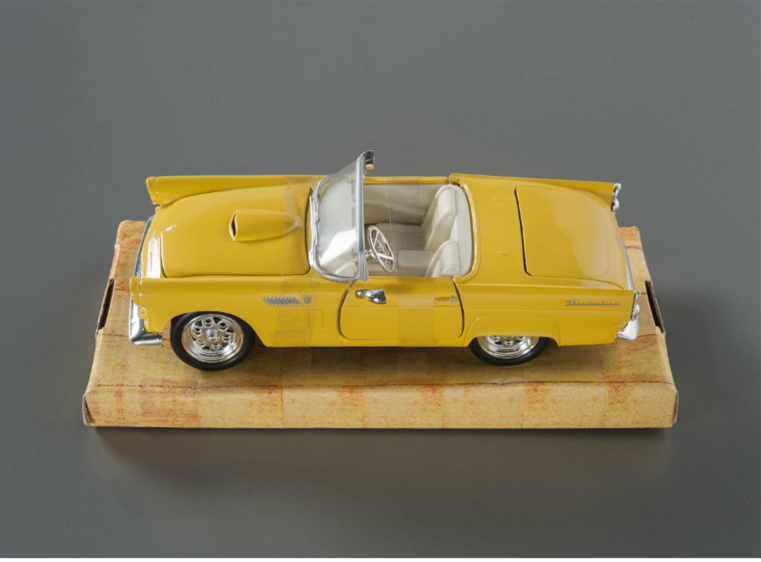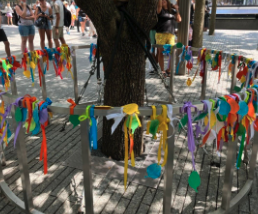An Intern Reflects: Pace University, the WTC, and 9/11
An Intern Reflects: Pace University, the WTC, and 9/11
- October 12, 2022

Toy model car belonging to victim Francisco Liriano, a Pace alumnus

2000-2001 Pace University brochure promoting its World Trade Institute
Guest blogger Victoria Seipp is a Pace University student who recently completed an internship with the Government & Community Affairs team at the 9/11 Memorial & Museum. In this post, she reflects on a special project she completed during her time with us and the connections she found between her university, the World Trade Center, and the day of the attacks.
The research for this piece was compiled using information and assistance from a wide breath of departments and internal databases at the 9/11 Memorial & Museum.
I began my project with the goal of understanding the historical context for the connection between Pace University and the original World Trade Center, which led me to the Urban Renewal Project. This project, a development push led by the Downtown Lower Manhattan Association to build a new, dedicated World Trade Center, inspired a broader mid-20th century renovation of the neighborhood. Pace College, which was not yet a university, was the focus of the educational component of this development project. As Pace was well known for its Lubin School of Business, it was an attractive nearby amenity that could be promoted to the investors at the World Trade Center. This led to the construction of 1 Pace Plaza in 1966. Two years later — just a few blocks away — the Port Authority of New York and New Jersey began construction of the Twin Towers.
The connection between Pace University and the World Trade Center expanded when Pace purchased the World Trade Institute (WTI), located on the North Tower's 55th floor. The WTI was a continuing education program for business professionals looking to specialize in modernized international trade. On 9/11, Pace’s Board of Trustees had scheduled a meeting on floor 55 but postponed the event due to delays in ongoing renovations on the floor.
For Pace students, 9/11 coincided with, at most, their second week of classes. As the events of this particular Tuesday unfolded before 9 a.m., most students and staff were still in their dorms or commuting. As the crisis situation escalated, students were quickly ordered to shelter in their dorms. One dorm building, 182 Broadway, is just four blocks away from the World Trade Center, leaving those students especially vulnerable.
When the South Tower collapsed at 9:59 a.m., the head of security at 1 Pace Plaza made a quick decision to shut off the air intake valves in the building. This gave those who were sheltering in the lobby time to collect themselves and create makeshift masks to protect themselves from the clouds of dust and thick fumes. One survivor who had fled the South Tower's 84th floor, Richard Fern, recalls that he was running away from the collapse when a security guard ushered him to safety inside the lobby of Pace University just seconds before the cloud of dust rushed by.
Forty-four individuals who were killed on 9/11 had connections to Pace University. The 40 alumni and four students are honored on the "Book of Remembrance" memorials situated on each of the three Pace University campuses. Loved ones have also donated items to the 9/11 Museum that speak to their memory, like a Yellow Thunderbird toy model car prized by victim Francisco Liriano, a program specialist at Citibank who was attending a meeting at Cantor Fitzgerald on the North Tower’s 105th floor.
Pace University reopened on Wednesday, September 19th, 2001, just eight days after the attacks. New York City students slowly returned to their dorms. Staff, including the university's president, made a point to meet students where they were — in the dining halls and dorms — making themselves available as a supportive presence.
Every one of Pace University’s New York City campus buildings is located inside the Exposure Zone as defined by the Victims Compensation Fund. Students or staff who were exposed to the dust cloud are eligible for the World Trade Center Health Program. As of June 2022, over 3,000 survivors have registered with it.
It is my hope that this research will serve as a building block for future Pace interns in their research to highlight the relationship between Pace University and the 9/11 Memorial & Museum.
By Victoria Seipp, 9/11 Memorial Intern
Previous Post
21st Anniversary Commemoration Highlights

Highlights from the 21st anniversary commemoration remind us that from New York City to Japan, people across the country and around the world come together to help preserve the legacy of September 11 and ensure that we never forget.
Next Post
Survivor Tree Inspires Messages of Hope

Our Art Cart invites summer visitors to leave a message of hope at the Survivor Tree, but the activity is one that can be completed at home any time of the year, just with just as much meaning.